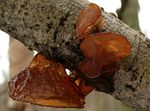
Tremella mesenterica is a common jelly fungus in the family Tremellaceae of the Agaricomycotina. It is most frequently found on both dead but attached and recently fallen branches, especially of angiosperms, as a parasite of wood decay fungi in the genus Peniophora. The gelatinous, orange-yellow fruit body of the fungus, which can grow up to 7.5 cm (3.0 in) diameter, has a convoluted or lobed surface that is greasy or slimy when damp. It grows in crevices in bark, appearing during rainy weather. Within a few days after rain it dries into a thin film or shriveled mass capable of reviving after subsequent rain. This fungus occurs widely in deciduous and mixed forests and is widely distributed in temperate and tropical regions that include Africa, Asia, Australia, Europe, North and South America. Although considered bland and flavorless, the fungus is edible. Tremella mesenterica produces carbohydrates that are attracting research interest because of their various biological activities.

The Tremellaceae are a family of fungi in the order Tremellales. The family is cosmopolitan and contains both teleomorphic and anamorphic species, most of the latter being yeasts. All teleomorphs in the Tremellaceae are parasites of other fungi, though the yeast states are widespread and not restricted to hosts. Basidiocarps, when produced, are gelatinous.
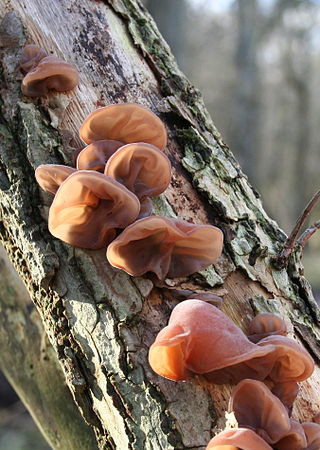
The Auriculariales are an order of fungi in the class Agaricomycetes. Species within the order were formerly referred to the "heterobasidiomycetes" or "jelly fungi", since many have gelatinous basidiocarps that produce spores on septate basidia. Around 200 species are known worldwide, placed in six or more families, though the status of these families is currently uncertain. All species in the Auriculariales are believed to be saprotrophic, most growing on dead wood. Fruit bodies of several Auricularia species are cultivated for food on a commercial scale, especially in China.

The Auriculariaceae are a family of fungi in the order Auriculariales. Species within the family were formerly referred to the "heterobasidiomycetes" or "jelly fungi", since many have gelatinous basidiocarps that produce spores on septate basidia. Around 100 species are known worldwide. All are believed to be saprotrophic, most growing on dead wood. Fruit bodies of several Auricularia species are cultivated for food on a commercial scale, especially in China.

The Tremellales are an order of fungi in the class Tremellomycetes. The order contains both teleomorphic and anamorphic species, most of the latter being yeasts. All teleomorphic species in the Tremellales are parasites of other fungi, though the yeast states are widespread and not restricted to hosts. Basidiocarps, when produced, are gelatinous.

The Hyaloriaceae are a family of fungi in the order Auriculariales. Species within the family have gelatinous basidiocarps that produce spores on septate basidia and, as such, were formerly referred to the "heterobasidiomycetes" or "jelly fungi". All appear to be saprotrophic, growing on dead wood or plant remains. Less than 30 species are currently included within the Hyaloriaceae, but the family has not been extensively researched.

Exidia glandulosa is a jelly fungus in the family Auriculariaceae. It is a common, wood-rotting species in Europe, typically growing on dead attached branches of oak. The fruit bodies are up to 3 cm (1.2 in) wide, shiny, black and blister-like, and grow singly or in clusters. Its occurrence elsewhere is uncertain because of confusion with the related species, Exidia nigricans.

Spongiforma thailandica is a species of fungus in the family Boletaceae, genus Spongiforma. The stemless sponge-like species, first described in 2009, was found in Khao Yai National Park in central Thailand, where it grows in soil in old-growth forests. The rubbery fruit body, which has a strong odor of coal-tar similar to Tricholoma sulphureum, consists of numerous internal cavities lined with spore-producing tissue. Phylogenetic analysis suggests the species is closely related to the Boletaceae genera Porphyrellus and Strobilomyces.

Exidia nigricans is a jelly fungus in the family Auriculariaceae. It is a common, wood-rotting species throughout the northern hemisphere, typically growing on dead attached branches of broadleaf trees. It has been much confused with Exidia glandulosa.

Sebacina is a genus of fungi in the family Sebacinaceae. Its species are mycorrhizal, forming a range of associations with trees and other plants. Basidiocarps are produced on soil and litter, sometimes partly encrusting stems of living plants. The fruit bodies are cartilaginous to rubbery-gelatinous and variously effused (corticioid) to coral-shaped (clavarioid). The genus has a cosmopolitan distribution.

Guepinia is a genus of fungus in the Auriculariales order. It is a monotypic genus, containing the single species Guepinia helvelloides, commonly known as the apricot jelly. The fungus produces salmon-pink, ear-shaped, gelatinous fruit bodies that grow solitarily or in small tufted groups on soil, usually associated with buried rotting wood. The fruit bodies are 4–10 cm (1.6–3.9 in) tall and up to 17 cm (6.7 in) wide; the stalks are not well-differentiated from the cap. The fungus, although rubbery, is edible, and may be eaten raw with salads, pickled, or candied. It has a white spore deposit, and the oblong to ellipsoid spores measure 9–11 by 5–6 micrometers. The fungus is widely distributed in the Northern Hemisphere, and has also been collected from South America.
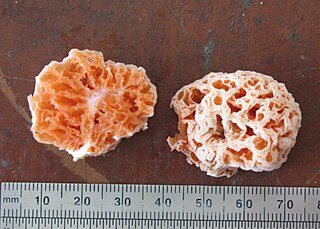
Spongiforma is a genus of sponge-like fungi in the family Boletaceae. Newly described in 2009, the genus contains two species: S. thailandica and S. squarepantsii. The type species S. thailandica is known only from Khao Yai National Park in central Thailand, where it grows in soil in old-growth forests dominated by dipterocarp trees. The rubbery fruit bodies, which has a strong odour of coal-tar similar to Tricholoma sulphureum, consists of numerous internal cavities lined with spore-producing tissue. S. squarepantsii, described as new to science in 2011, is found in Malaysia. It produces sponge-like, rubbery orange fruit bodies with a fruity or musky odour. These fruit bodies will—like a sponge—resume their original shape if water is squeezed out. The origin of the specific name derives from its perceived resemblance to the cartoon character SpongeBob SquarePants. Apart from differences in distribution, S. squarepantsii differs from S. thailandica in its colour, odour, and spore structure.

Exidia recisa is a species of fungus in the family Auriculariaceae. In the UK, it has the recommended English name of amber jelly. Basidiocarps are gelatinous, orange-brown, and turbinate (top-shaped). It typically grows on dead attached twigs and branches of willow and is found in Europe and possibly elsewhere, though it has long been confused with the North American Exidia crenata.
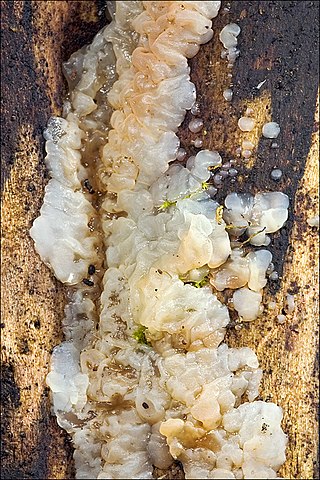
Exidia thuretiana is a jelly fungus in the family Auriculariaceae. The fruit bodies are white and gelatinous with brain-like folds. It is a common, wood-rotting species in Europe, typically growing on dead attached or fallen branches of broadleaf trees, especially beech.

Myxarium nucleatum is a species of fungus in the family Hyaloriaceae. In the UK, it has been given the recommended English name of crystal brain. Basidiocarps are watery white, pustular or lobed, and gelatinous with small, white, mineral inclusions visible to the naked eye. It is a common, wood-rotting species in Europe, typically growing on dead attached or fallen branches of broadleaf trees. It is currently not clear whether collections from North America and elsewhere represent the same species.

Auricularia auricula-judae, commonly known as jelly ear and previously known as Jew's ear, is a species of fungus in the order Auriculariales. Basidiocarps are brown, gelatinous, and have a noticeably ear-like shape. They grow on wood, especially elder. The specific epithet is derived from the belief that Judas Iscariot hanged himself from an elder tree.
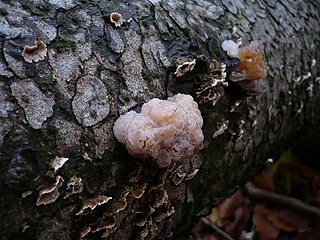
Naematelia is a genus of fungi in the family Naemateliaceae. All Naematelia species are parasites of other fungi and produce anamorphic yeast states. When produced, Basidiocarps ,, are gelatinous and are colloquially classed among the "jelly fungi."Four species of Naematelia are currently recognized worldwide. One species, Naematelia aurantialba, is commercially cultivated for food.
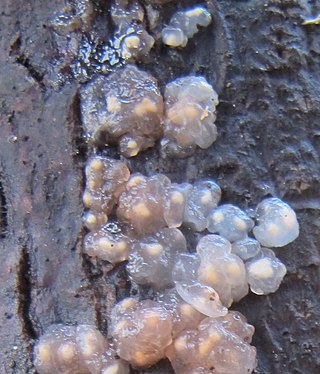
Myxarium is a genus of fungi in the family Hyaloriaceae. Basidiocarps are gelatinous and effused or pustular. The genus is cosmopolitan. All species grow on dead wood or dead herbaceous stems.
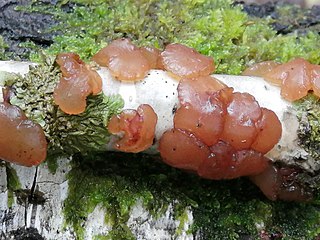
Exidia repanda is a species of fungus in the family Auriculariaceae. In the UK, it has the recommended English name of birch jelly. Basidiocarps are gelatinous, orange-brown, and button-shaped. It typically grows on dead attached twigs and branches of birch and has been recorded from Europe, North America, and Japan.
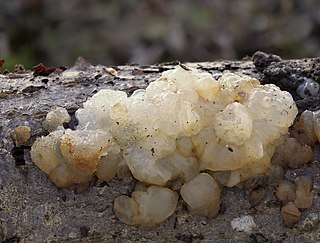
Exidia candida is a species of fungus in the family Auriculariaceae. Basidiocarps are gelatinous, whitish, and cushioned-shaped at first, becoming effused and corrugated. It typically grows on logs and fallen branches of lime and other broadleaved trees. The species occurs in both North America and Europe. A distinctive variety, Exidia candida var. cartilaginea, is bicoloured whitish and ochre to brown, grows preferentially on birch and alder, has a northerly distribution, and occurs in North America, Europe, and the Russian Far East.






